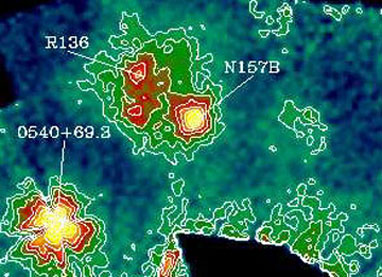Newly Discovered Pulsar Spins its Way into History
 |
ASCA image of N157B
Credit: Wang & Gotthelf (ApJ, 1998, 494, 623) |
Astronomers have discovered a neutron star spinning at a rate of over 60
times a second! The star, a pulsar believed to have formed in a supernova
explosion some five thousand years ago, is spinning faster than most
scientists believed possible for such an object. The pulsar was found by a
team of astronomers including Frank Marshall, William Zhang, and Eric
Gotthelf from NASA's Goddard Space Flight Center, along with John
Middleditch from Los Alamos National Laboratory. "The pulsar is spinning
twice as fast as any young pulsar that we have seen before," said
Marshall. "To put it in perspective, this pulsar is spinning more than 6
million times as rapid as the Earth."
Astronomers compared this newly found pulsar with the pulsar in the Crab
supernova remnant and found:
| N157B | Crab |
| age | 5000 yrs | 1000
yrs |
| current period | 16 ms | 33 ms |
| spin-down rate * | 5.12
e-14s/s | 4.2269 e-13s/s |
So the N157B pulsar is much older but has spun down about ten times more
slowly, and thus retained much of its initial spin. This might be due to
the relative magnetic field strength of the pulsars. This important new
addition to the class of rotation-powered pulsars helps constrain models
of neutron star spin rates at birth.
N157B was discovered by analysis of data from NASA's Rossi X-rayTiming Explorer (RXTE) (http://rxte.gsfc.nasa.gov/docs/xte/learning_center/). The results were then confirmed using
observations by the joint Japanese/U.S. Advanced Satellite for
Cosmology and Astrophysics (ASCA). Further observations will better
constrain the age of the pulsar, look for and measure a deceleration of
the period and verify the existence of glitches in the emission.
* Crab spindown rate from Zombeck, pg 192, citing Seward, 1978, JBIS
31, pg83
* N157B spindown rate from Wang et al. Volume 494 of the
astrophysical Journal
Additional Links
 Take me to the Structure and Evolution of the Universe Press Release on this discovery! (ftp://ftp.hq.nasa.gov/pub/pao/pressrel//1998/98-014.txt) Take me to the Structure and Evolution of the Universe Press Release on this discovery! (ftp://ftp.hq.nasa.gov/pub/pao/pressrel//1998/98-014.txt)
|
